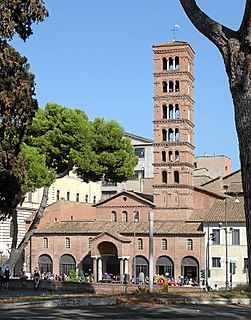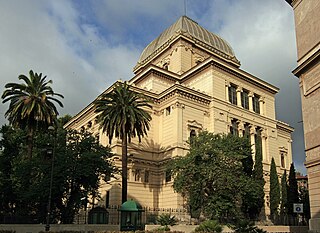
The Circus Flaminius was a large, circular area in ancient Rome, located in the southern end of the Campus Martius near the Tiber River. It contained a small race-track used for obscure games, and various other buildings and monuments. It was "built", or sectioned off, by Gaius Flaminius in 221 BC. After Augustus divided the city into 14 administrative regions, the Circus Flaminius gave its name to Region IX, which encompassed the Circus and all of the Campus Martius west of the Via Lata.

The Theatre of Pompey was a structure in Ancient Rome built during the latter part of the Roman Republican era by Pompey the Great. Completed in 55 BC, it was the first permanent theatre to be built in Rome.

The Imperial fora are a series of monumental fora, constructed in Rome over a period of one and a half centuries, between 46 BC and 113 AD. The fora were the center of the Roman Republic and of the Roman Empire.

The Basilica of Saint Mary in Cosmedin is a minor basilica church in Rome, Italy. It is located in the rione of Ripa.

Sant'Angelo is the 11th rione of Rome, Italy, located in Municipio I. Often written as rione XI - Sant'Angelo, it has a coat of arms with an angel on a red background, holding a palm branch in its left hand. In another version, the angel holds a sword in its right hand and a scale in its left.

The Porticus Octaviae is an ancient structure in Rome. The colonnaded walks of the portico enclosed the temples of Jupiter Stator and Juno Regina, as well as a library. The structure was used as a fish market from the medieval period, and up to the end of 19th century.

The Saepta Julia was a building in the Campus Martius of Rome, where citizens gathered to cast votes. The building was conceived by Julius Caesar and dedicated by Marcus Vipsanius Agrippa in 26 BCE. The building replaced an older structure, called the Ovile, built as a place for the comitia tributa to gather to cast votes. The Saepta Julia can be seen on the Forma Urbis Romae, a map of the city of Rome as it existed in the early 3rd century CE. Part of the original wall of the Saepta Julia can still be seen right next to the Pantheon.
The Porticus Octavia was a portico in ancient Rome, built by Gnaeus Octavius in 168BC to commemorate a naval victory over Perseus of Macedonia. It stood between the Theatre of Pompey and the Circus Flaminius. Pliny describes it as a double portico with bronze Corinthian capitals, for which it was also called the Porticus Corinthia. It may have been the earliest use of this architectural order in Rome, and is possibly to be identified with remains in the Via S. Nicola ai Cesarini, represented in the Severan Marble Plan. Velleius Paterculus called it multo amoenissima, or "by far the loveliest" of the porticoes, but has left no traces.

The Temple of Apollo Sosianus is a Roman temple dedicated to Apollo in the Campus Martius, next to the Theatre of Marcellus and the Porticus Octaviae, in Rome, Italy. Its present name derives from that of its final rebuilder, Gaius Sosius.

Santa Maria in Campitelli or Santa Maria in Portico is a church dedicated to the Virgin Mary on the narrow Piazza di Campitelli in Rione Sant'Angelo, Rome, Italy.

The Temple of Jupiter Stator was a temple of Ancient Rome in the southern Campus Martius. It was destroyed in 64 AD in the Great Fire of Rome.

The Porticus Deorum Consentium, sometimes known as the Area of the Dii Consentes, is an ancient structure located at the bottom of the ancient Roman road that leads up to the Capitol in Rome, Italy. The Clivus Capitolinus turned sharply at the head of the Forum Romanum where this portico of marble and composite material was discovered and re-erected in 1835.
The Porticus Argonautarum was an ancient structure in Rome.
The Porticus Catuli was a landmark on the Palatine Hill in ancient Rome. It was built by Quintus Lutatius Catulus to commemorate his joint victory with Gaius Marius over the Cimbri at Vercellae.

The Porticus of Pompey was a large quadriporticus located directly behind the scaenae frons of the Theatre of Pompey. It enclosed a large and popular public garden in the ancient city of Rome. The porticus was finished in 62 BC. and has a history spanning hundreds of years. The colonnades contained arcades and gallaries that displayed sculptures and paintings collected from years of war campaigns of its patron and builder, Gnaeus Pompeius Magnus. Over time the site became rows of shops that occupied what were the galleries and arcades. As the ground level rose from constant flooding from the Tiber River, much of the original architectural elements were re-used by shop owners to adhorn their structures at higher levels. Today, many of these shops still exist and fragments of the old theatre and porticus can be seen embedded in the ancient walls of many of the buildings.

Porticus Aemilia was a portico in ancient Rome. It was one of the largest commercial structures of its time and functioned as a storehouse and distribution center for goods entering the city via the Tiber river.

The Palace of Domitian was built as Roman emperor Domitian's official residence in 81–92 AD and was used as such by subsequent emperors. Its remains sit atop and dominate the Palatine Hill in Rome, alongside other palaces.
The Temple of Juno Regina was a temple in ancient Rome dedicated to "Queen Juno". It was near the Circus Flaminius in the southern half of the Campus Martius. It was vowed by consul Marcus Aemilius Lepidus in 187 BC during his final battle against the Liguri and dedicated on 23 December 179 BC, whilst he was censor. It was linked by a portico to a temple of Fortuna, possibly the temple of Fortuna Equestris. It was probably to the south of the Portico of Pompey, on the western side of the circus Flaminius.

The Portico of Livia was a portico in Regio III Isis et Serapis of ancient Rome. It was built by Augustus in honour of his wife Livia Drusilla and is located on the Esquiline Hill. Although little of its structure survives now, it was one of the most prominent porticos in the ancient city. The so-called Ara Concordia was located either in or near to the portico.

The Regio IX Circus Flaminius is the ninth regio of imperial Rome, under Augustus's administrative reform. Regio IX took its name from the racecourse located in the southern end of the Campus Martius, close to Tiber Island.















